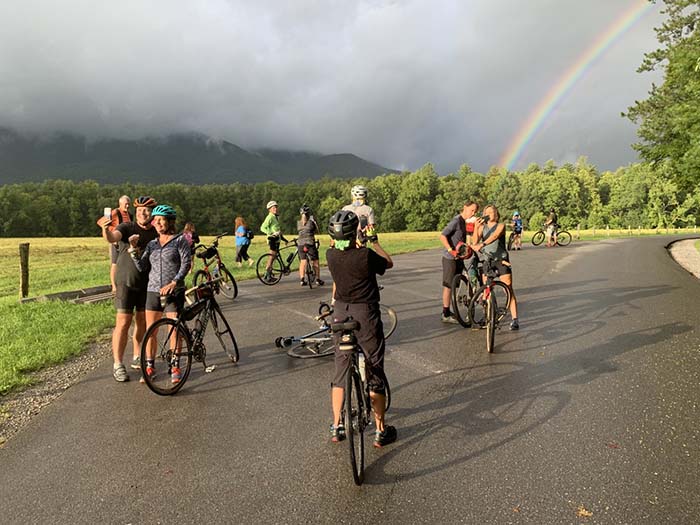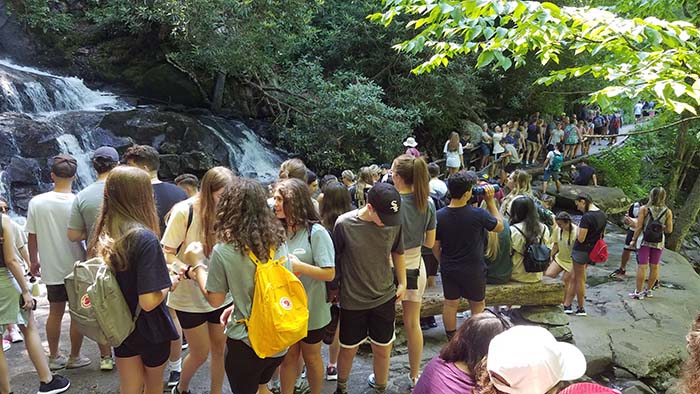| |
Cades Cove, Laurel Falls Trail pilot project outcomes
January 13, 2022

Cades Cove vehicle free day; image by GSMNP |
GSMNP - Great Smoky Mountains National Park officials recently assessed monitoring data collected during the Cades Cove Vehicle-Free Day and Laurel Falls Trail Congestion Management pilot projects in 2021. Both pilot projects aimed to improve safety, visitor experience, and resource protection. Based on assessments, park managers announced the permanent implementation of full-day, vehicle-free Wednesday opportunities for Cades Cove Loop Road beginning May 4 through September 28 in 2022. Visitor use management strategies for Laurel Falls will continue to be reviewed as a part of the Laurel Falls Trail Management Plan Environmental Assessment (EA). Until this process is complete, no reservation or shuttle systems are planned for Laurel Falls.
Visitor feedback was positive for the second year of the Cades Cove Vehicle-Free Day pilot with 84% of visitors providing supportive comments. Approximately 42% of commenters requested additional vehicle-free access opportunities on the Cades Cove Loop Road. An average of 1,296 visitors participated each Wednesday from May 5 through Sept. 1, 2021. On average, 44% of those visitors walked and 56% cycled the Loop Road. The full day approach, along with on-site parking management, allowed better access and more opportunities to enjoy the experience throughout the day. Parking was generally available 82% of the time, however, parking lots were consistently full during the morning hours. Park managers will continue to manage and monitor the parking areas similarly in 2022. Visitors are encouraged to come in the afternoon and evening hours for a better chance of securing a parking space. Learn more about vehicle-free days.

Laurel Falls foot traffic; image by GSMNP |
Most commenters, 91%, supported the Laurel Falls Trail pilot project. During the pilot period, trailhead parking was provided by reservation only and no parking was permitted in undesignated areas along Little River Road from Sept. 7 through Oct. 23, 2021. Parking reservations, which were available for two-hour time blocks, were made online at www.recreation.gov for a fee of $14 per vehicle. These fees were used to staff the parking lot, provide on-site portable toilets, and purchase roadside signage and barriers. Managing access through the reservation and shuttle system was expected to spread use more evenly throughout the day, creating a less crowded and more enjoyable experience on the trail and at the falls. Overall, visitors experienced lower rates of litter and a reduction in crowding during the pilot. An average of less than one grocery bag of trash was collected by volunteers during a six-hour shift, which was down significantly from an average of 2.2 bags prior to the pilot.
The Laurel Falls Trail Management Plan EA will consider management strategies such as those employed during the pilot project. Park managers plan to hold a public scoping period for the EA by early summer and then release the EA for public comment later in the year. Specific dates for these public comment periods will be announced in future news releases.
Visitor Experience Stewardship Background:
In October 2020, the park initiated a visitor experience stewardship engagement process. Park staff held eight virtual workshops with the public, employees, volunteers, and partners to collect their input on congestion and crowding in the park. As a part of the workshop, park staff presented information about the current state of the park and a visitor use expert presented congestion management solutions that have been implemented on public lands across the country and globe.
Over 200 people attended the workshops and provided input on their ideal park experiences as well as their opinions on how sites could be better managed. Because the workshops were virtual, people from all over the country had the opportunity to participate. Additionally, park staff collected feedback via the Planning, Environment & Public Comment (PEPC) system. People from 28 states provided feedback through the PEPC system. There were 391 submissions collected through the PEPC system. Participants had the opportunity to comment about any area in the park but were prompted to discuss the following sites: Cades Cove Day Use Area, Laurel Falls Trail, Clingmans Dome Day Use Area, Alum Cave Trail, Chimney Tops Trail, Rainbow Falls Trail, Trillium Gap Trail, and Big Creek Day Use Area.
Laurel Falls Trail:
The park received 220 submissions related to Laurel Falls Trail through the Visitor Experience Stewardship engagement process. The 1.3-mile section of Laurel Falls Trail that leads to the falls is one of the most popular trails in the park with more than 375,000 visits in 2020, an increase of over 110,000 visitors compared to 2019. The high level of Laurel Falls Trail use has resulted in congestion along the trail, crowding at the falls, and unsafe conditions along Little River Road (Fighting Creek Gap Road on some maps). Vehicles parked along the roadside obstruct the flow of traffic and create blind-spots for motorists, while visitors walking to or from their vehicles in the lanes of traffic are at risk of being struck by passing vehicles. Roadside parking also impacts adjacent habitats, damages road edges, and causes erosion.
Some of the key features of a desirable visitor experience for Laurel Falls trail brought forth through the visitor experience stewardship civic engagement process include the following:
• Visitors have the opportunity to access safety information before beginning their hike. Visitors experience a well-ordered flow of foot traffic to the falls.
• Visitors have adequate physical space and time to enjoy and perhaps take photographs of the falls.
• Parking is available in designated spots.
• Visitors can safely travel from their vehicle to the trail head.
Participants of the visitor experience stewardship civic engagement proposed various management practices to improve Laurel Falls trail, including the following:
• Reduce or eliminate roadside parking
• Charge a parking lot fee
• Make repairs to the trail and falls viewing area
• Increase the presence of rangers and volunteers in the parking area and on the trail
• Provide information about congestion conditions to the public
• Provide alternative transportation to the trailhead from the surrounding gateway communities
The Laurel Falls Trail Congestion Management Pilot addressed key concerns identified by the public during the Visitor Experience Stewardship civic engagement workshops in the fall of 2020. During these workshops, the public expressed concerns about litter, the availability of and safe passage to and from parking areas, the flow of traffic on the trail, and inadequate space and time to view and photograph the falls. In 2021, 97% of parking reservations offered during the pilot period were sold and only 16% of reservation-holders did not show during their allotted time. The average length of stay for reservation holders during the pilot was 104 minutes, which was within the allowable 2-hour reservation block. Additionally, Rocky Top Tours provided shuttle access to the trailhead from nearby, Gatlinburg. On average, shuttles were 30% full for an average daily ridership of 83 people.
Cades Cove:
For over 40 years, park managers implemented several vehicle-free opportunities for bicyclists and pedestrians in Cades Cove. Prior to 2020, the road was closed to vehicles on Wednesday and Saturday mornings until 10:00 a.m. from May through September. Under the morning-only closure model, traffic leading to Cades Cove area was often gridlocked by a line of motorists waiting for the Loop Road to open to motor vehicles at 10:00 a.m. In addition, the entire developed area was congested with parked vehicles. After filling the designated parking areas, visitors often used inappropriate areas for parking such as road shoulders and campsites. In 2020, park managers implemented a pilot project for a full-day vehicle-free period. The intent of the pilot project was to test whether visitor use could be effectively spread throughout the day to address congestion, parking, and safety issues associated with the vehicle-free period and to provide improved access to multiple user groups. In 2021, the pilot project was extended with a modified parking plan. |

